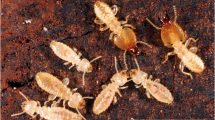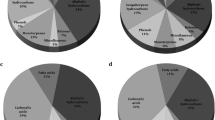Abstract
Sixteen terpene compounds were isolated from the soldier defensive secretions of seven European termite taxa of the genus Reticulitermes (Isoptera, Rhinotermitidae). We describe species-specific mixtures of monoterpenes (α-pinene, β-pinene, limonene), sesquiterpenes (germacrene C, germacrene A, germacrene B, β-selinene, δ-selinene, γ-selinene, (E)-β-farnesene, γ-cadinene, nerolidol), diterpenes (geranyl linalool, geranyl geraniol, geranyl geranial), and one sesterterpene (geranyl farnesol). Compounds were purified by HPLC and their structures determined by means of MS spectrometry, or 1D and 2D NMR spectroscopy. Comparison of two different analytical approaches, GC-MS and HPLC with subsequent NMR spectroscopy, revealed Cope rearrangement of germacrene A, germacrene B, and germacrene C to the respective β-elemene, γ-elemene, and δ-elemene under GC conditions, thus demonstrating the limits for this analytical approach. The species-specific compound composition provides insight into taxonomy and species origin of European Reticulitermes. The biological significance of the species-specific composition of Reticulitermes defensive secretions is briefly discussed.
Similar content being viewed by others
References
Bagnères, A.-G., Clément, J.-L., Lange, C., and Joulie, C. 1988. Les hydrocarbures cuticulaires des Reticulitermes français: variations spécifiques et coloniales. Actes Collog. Insectes Soc. 4:34–42.
Bagnères, A.-G., Clément, J. L., blum, M. S., Severson, R. F., Joulie, C., and Lange, C. 1990. Cuticular hydrocarbons and defensive compounds of Reticulitermes flavipes (Kollar) and R. santonensis (Feytaud): Polymorphism and chemotaxonomy. J. Chem. Ecol. 16:3213–3244.
Bagnères, A.-G., Killian, A., Clément, J.-L., and Lange, C. 1991. Interspecific recognition among termites of the genus Reticulitermes. Evidence for a role 10 for the hydrocarbons. J. Chem. Ecol. 17:2397–2420.
Baker, R., Parton, A. H., and Howse, P. E. 1982. Identification of an acyclic diterpene alcohol in the defense secretion of soldiers of Reticulitermes lucifugus. Experientia 38:297–298.
Bartelt, R. J., Cosse, A. A., Zilkowski, B. W., Weisleder, D., and Momany, F. A. 2001. Male-specific sesquiterpenes from Phyllotreta and Aphthona flea beetles. J. Chem. Ecol. 27:2397–2423.
Becker, G. 1970. Reticulitermes in Mittel-und West-Europa. Z. Angew. Entomol. 65:268–278.
Becker, G. 1981. Behaviour differences in Reticulitermes, pp. 283–288, in P. E. Howse and J.-L. Clément (Eds.). Biosystematics of Social Insects. Academic Press, New York.
Boeve, J.-L., Heilpor, S., Dettner, K. and Francke, W. 2000. The secretion of the ventral glands in Cladius, Priophorus and Trichiocampus sawfly larvae. Biochem. Syst. Ecol. 28:857–864.
Bouillon, A. 1981. Mechanisms of species isolation in termites, pp. 297–307, in P. E. Howse and J.-L. Clément (Eds.). Biosystematics of Social Insects. Academic Press, London.
Clément, J.-L. 1978. Nouveaux critères taxonomiques dans le genre Reticulitermes, description de nouveaux taxons français. Ann. Soc. Entomol Fr. 14:131–141.
Clément, J.-L. 1981. Enzymatic polymorphism in the European populations of various Reticulitermes species, pp. 49–61, in P. E. Howse and J.-L. Clément (Eds.). Biosystematics of Social Insects. Academic Press, London.
Clément, J.-L. 1984. Diagnostic alleles of species in Reticulitermes. Experientia 40:283–285.
Clément, J. L., Lemaire, M., Nagnan, P., Escoubas, P., Bagneres, A.-G., and Joulie, C. 1988. Chemical ecology of European termites of the genus Reticulitermes: allomones, pheromones and kairomones. Sociobiology 14:165–174.
Clément, J.-L., Bagneres, A.-G., Uva, P., Wilfert, L., Quintana, A., Reinhard, J., and Dronnet, S. 2001. Biosystematics of Reticulitermes termites in Europe: morphological, chemical and molecular data. Insectes Soc. 48:202–215.
De Kraker, J.-W., Franssen, M. C, De Groot, A., Shibata, T., and Bouwmeester, H. J. 2001. Germacrenes from fresh costus roots. Phytochemistry 58:481–487.
Deligne, J., Quennedey, A., and Blum, M. S. 1981. The enemies and defense mechanisms of termites, pp. 1–76, in H. R. Hermann (ed.). Social Insects, Vol II. Academic Press, New York.
Feytaud, J. 1924. Le termite de Saintonge. C.R. Acad. Sci. Paris 178:241–244.
Grassé, P. P. 1982. Termitologia, Vol. 1. Masson, Paris.
Grassé, P. P. 1984. Termitologia, Vol. 2. Masson, Paris.
Grassé, P. P. 1986. Termitologia, Vol. 3. Masson, Paris.
Hanson, J. R. 2001. The development of strategies for terpenoid structure determination. Nat. Prod. Rep. 18:607–617.
Haverty, M. and Nelson, L. J. 1997. Cuticular hydrocarbons of Reticulitermes (Isoptera: Rhinotermitidae) from northern California indicate undescribed species. Comp. Biochem. Physiol. 118B:869–880.
Haverty, M., Forschler, B., and Nelson, L. J. 1996. An assessment of the taxonomy of Reticulitermes from the Southeastern United States based on cuticular hydrocarbons. Sociobiology 28:287–318.
Haverty, M., Nelson, L., and Forschler, B. 1999. New cuticular hydrocarbon phenotypes of Reticulitermes from the United States. Sociobiology 34:1–21.
Jenkins, T. M., Haverty, M. I., Basten, C. J., Nelson, L. J., Page, M., and Forschler, B. T. 2000. Correlation of mitochondrial haplotypes with cuticular hydrocarbon phenotypes of sympatric Reticulitermes species from the southeastern United States. J. Chem. Ecol. 26:1525–1542.
Jenkins, T. M., Dean, R. E., Verkerk, R., and Forschler, B. T. 2001. Phylogenetic analyses of two mitochondrial genes and one nuclear intron region illuminate European subterranean termite (Isoptera: Rhinotermitidae) gene flow, taxonomy, and introduction dynamics. Mol. Phylogen. Evol. 20:286–293.
Joulain, D., and Konig, W. 1998. The Atlas of Spectral Data of Sesquiterpene Hydrocarbons. E.B.-Verlag, Hamburg.
Juettner, F. and Bogenschuetz, D. 1983. Geranyl derivatives as inhibitors of the carotenogenesis in Synechoccus PCC-6911 cyanobacteria. Z. Naturforsch. C, Biosci. 38:387–392.
Kaib, M. 1985. Defense strategies of termites: A review exemplified by Schedorhinotermes lamanianus. Mitt. Dtsch. Ges. Allg. Angew. Entomol. 4:301–306.
Konig, W., Bulow, N., Fricke, C., Melching, S., Rieck, A., and Muhlet, H. 1996. The sesquiterpene constituents of the liverworth Preissia quadrata. Phytochemistry 43:629–633.
Lemaire, M., Nnagnan, P., Clement, J.-L., Lange, C., Peru, L., and Basselier, J. J. 1990. Geranyllinalool (diterpene alcohol): An insecticidal component of pine wood and termites (Isoptera:Rhinotermitidae) in four European ecosystems. J. Chem Ecol. 16:2067–2079.
Nelson, L. J., Cool, L. G., Forschler, B. T., and Haverty, M. I. 2001. Correspondence of soldier defense secretion mixtures with cuticular hydrocarbon phenotypes for chemotaxonomy of the termite genus Reticulitermes in north America. J. Chem. Ecol. 27:1449–1479.
Parton, A. H., Howse, P. E., Baker, R., and Clément, J.-L. 1981. Variation in the chemistry of the frontal gland secretion of European Reticulitermes species, pp. 193–209, in P. E. Howse and J.-L. Clément (Eds.). Biosystematics of Social Insects. Academic Press, London.
Prestwich, G. D. 1979a. Chemical defense by termite soldiers. J. Chem. Ecol. 5:459–480.
Prestwich, G. D. 1979b. Termite chemical defense: new natural products and chemosystematics. Sociobiology 4:127–138.
Prestwich, G. D. 1983. Die chemischen Waffen Termiten. Spektrum Wissenschaft 10:70–80.
Prestwich, G. D. 1988. The chemicals in termite societies (Isoptera). Sociobiology 14:175–191.
Quennedey, A. and Deligne, J. 1975. L'arme frontale des soldats de termites. I. Rhinotermitidae. Insectes Soc. 22:243–267.
Reinhard, J. and Clément, J.-L. 2002. Alarm reaction of European Reticulitermes termites to soldier head capsule volatiles (Isoptera, Rhinothermitidae). J. Insect Behav. 15:95–107.
Roisin Y., Everaerts C., Pasteels J. M., and Bonnard, O. 1990. Caste-dependent reactions to soldier defensive secretion and chiral alarm/recruitment pheromone in Nasutitermes princeps. J. Chem. Ecol. 16:2865–2875.
Shinoda, T., Nagao, T., Nakayama, M., Serizawa, H., Koshioka, M., Okabe, H., and Kawai, A. 2002. Identification of a triterpenoid saponin from a crucifer, Barbarea vulgaris, as a feeding deterrent to the diamondback moth, Plutella xylostella. J. Chem. Ecol. 28:587–599.
Vieau, F. 2001. Comparison of the spatial distribution and reproductive cycle of Reticulitermes santonensis Feytaud and Reticulitermes lucifugus grassei Clément (Isoptera, Rhinotermitidae) suggests that they represent introduced and native species, respectively. Insectes Soc. 48:57–62.
Wheeler, G. S., Massey, L. M., and Southwell, I. A. 2002. Antipredator defense of biological control agent Oxyops vitiosa is mediated by plant volatiles sequestered from the host plant Melaleuca quinquenervia. J. Chem. Ecol. 28:297–315.
Zalkow, L., Howard, R., Gelbaum, L., Gordon, M., Deutsch, H., and Blum, M. 1981. Chemical ecology of Reticulitermes flavipes (Kollar) and R. virginicus (Banks) (Rhinotermitidae): chemistry of the soldier cephalic secretions. J. Chem. Ecol. 7:717–731.
Author information
Authors and Affiliations
Corresponding author
Rights and permissions
About this article
Cite this article
Quintana, A., Reinhard, J., Faure, R. et al. Interspecific Variation in Terpenoid Composition of Defensive Secretions of European Reticulitermes Termites. J Chem Ecol 29, 639–652 (2003). https://doi.org/10.1023/A:1022868603108
Issue Date:
DOI: https://doi.org/10.1023/A:1022868603108




